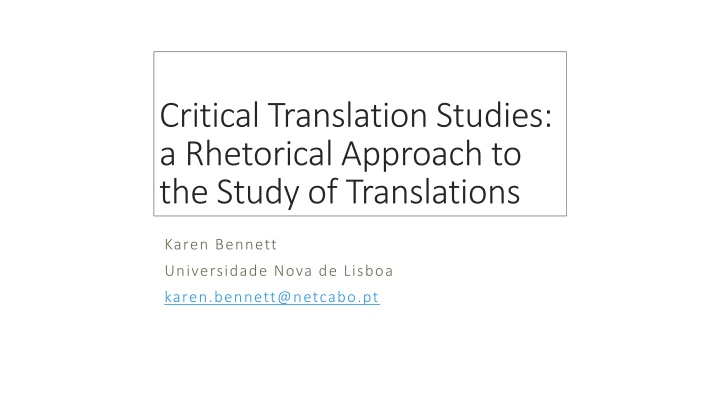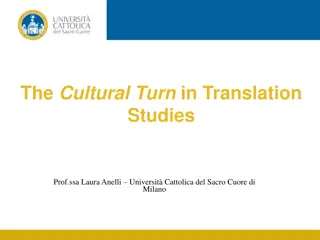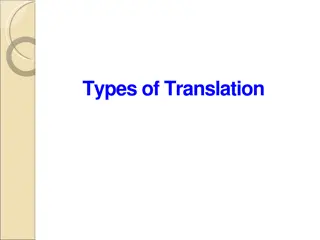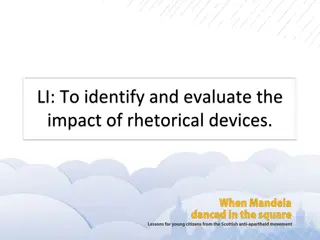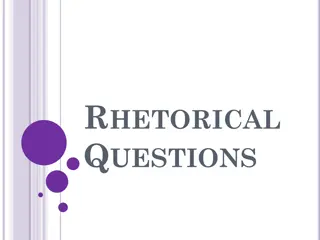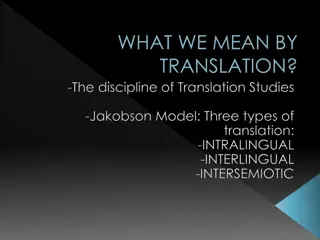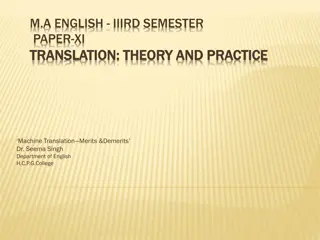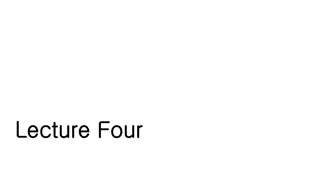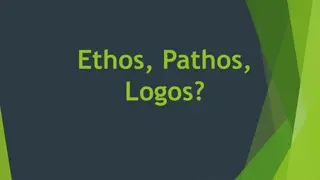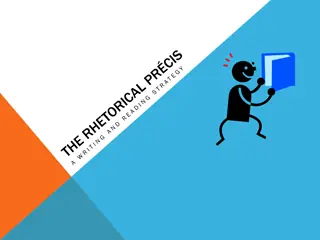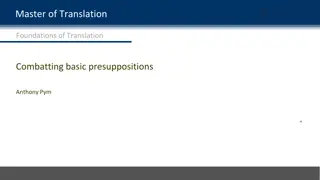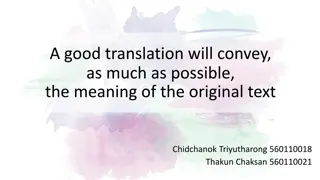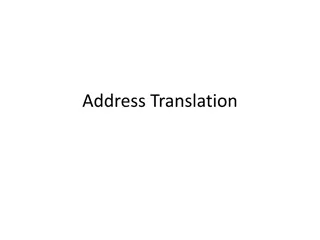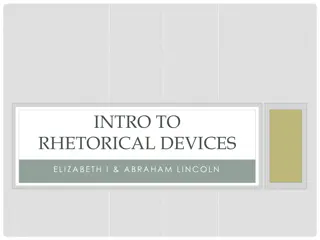Rhetorical Approach to Translation Studies: Challenges and Perspectives
This study explores the emergence of a rhetorical approach in Translation Studies, aiming to counter empiricism and highlight the importance of subjectivity and interpretation in translation. By examining paradigms in Translation Studies, it contrasts the scientistic drive for objectivity with a humanistic model that considers cultural complexities and the power dynamics inherent in translation acts. The reign of empiricism in recent years is discussed, along with efforts to reconcile different theoretical approaches in the field.
Download Presentation

Please find below an Image/Link to download the presentation.
The content on the website is provided AS IS for your information and personal use only. It may not be sold, licensed, or shared on other websites without obtaining consent from the author.If you encounter any issues during the download, it is possible that the publisher has removed the file from their server.
You are allowed to download the files provided on this website for personal or commercial use, subject to the condition that they are used lawfully. All files are the property of their respective owners.
The content on the website is provided AS IS for your information and personal use only. It may not be sold, licensed, or shared on other websites without obtaining consent from the author.
E N D
Presentation Transcript
CriticalTranslationStudies: a RhetoricalApproachto the Studyof Translations Karen Bennett Universidade Nova de Lisboa karen.bennett@netcabo.pt
Introduction This approach to the study of translations has arisen in response to the need to counter the creeping empiricism that is afflicting Translation Studies in the current climate of neoliberal utilitarianism. By analogy with Critical Pedagogies, Critical Discourse Analysis, etc, it rejects the scientistic drive for objectivity, neutrality and universalism in favour of a humanistic approach that privileges the role of subjectivity and interpretation, thereby drawing attention to the power issues inherent in the translational act. Its main inspiration is drawn from the rhetorical attitude to the construction of knowledge, which is holistic in the sense that: a) it values the emotive (pathos) and ethical (ethos) aspects of discourse as much as the rational (logos); b) it is grounded on an epistemology that understands the meaning of a text to be inseparable from its form. Work undertaken under this rubric aims above all to shed light on the unconscious assumptions, beliefs and values underpinning a translated text. It therefore enables ideological/ethical engagement, without being defined or limited by it.
Paradigms in Translation Studies TS has often been characterized as an inter-discipline torn between competing epistemological models: a) a scientistic model rooted in the desire for objectivity and descriptive neutrality, which aims to uncover universal rules or norms that can satisfactorily explain and predict the full range of translational phenomena; b) a humanistic model which understands that knowledge of the cultural world can never be neutral and value-free, and meanings are inherently unstable and partial, interpretable only on a case-by-case basis. This dichotomy has been described in various ways: linguistics vs. cultural studies paradigms (Baker 1996) essentialist vs. non-essentialist approaches (Arrojo 1998) instrumental vs. hermeneutic theories of language (Venuti 2000, after Kelly 1979) empiricism vs. postmodernism (Delabastita 2003) empirical science paradigm vs. liberal arts paradigm (Gile 2005) Around the turn of the millennium, there were attempts to reconcile these approaches: Chesterman and Arrojo s (2000) statement of shared ground Brownlie s (2003) Critical Descriptivism (a refinement of the traditional empiricist approach of Descriptive Translation Studies)
The reignof empiricism Since the turn of the millennium, the empiricist paradigm has increased its visibility in TS at the expense of humanistic models. This is particularly visible in discussions of Research Methods: Williams & Chesterman 2003: makes a preliminary distinction between conceptual and empirical research but devotes very little attention to the former Saldanha & O Brien 2014: despite claiming to offer an overview of the various ways of viewing the social world and the epistemological positions linked to them, the focus is on empirical (product-oriented, process-oriented and participant- oriented) research, with an almost complete disregard of theoretical or conceptual or hermeneutic approaches (Chesterman 2016) Indeed, for some, research is by definition empirical: e.g. In order to achieve verifiable results, all research whatever the field rests ultimately on observation of the world of experience and the collection and assessment of data resulting from those observations. Data that can be observed, tested, analyzed, and replicated are the bedrock of research. (Tymoczko 2007:141) There are, however, signs that this situation may be changing. A new volume about research methods in translation and interpreting explicitly aims at the merging of research paradigms (Angelelli & Baer 2016: 6).
Critical Approaches Tymoczko (2000:40): calls for a methodology and terminology to enable the development of a theory and praxis of translation as a form of social engagement. Brownlie (2003): coins the term Critical Descriptivism to bridge the gap between the two paradigms, though this is really only a refinement of the empiricist approach of Descriptive TS, defined in opposition to committed approaches Koskinen (2004:153-4): uses Critical Translation Studies to refer to a range of approaches previously considered under the postmodern rubric, noting that the critical paradigm of Translation Studies / / is not methodologically unified, nor does it share an overarching theory , but rather is characterized by a shared belief that the task of the researcher is not only to describe and explain but also to attempt to improve the situation or to offer solutions to a perceived problem . Baker (2009, 2010): publishes two edited volumes with the word critical in their title: Translation Studies: Critical Concepts in Linguistics and Critical Readings in Translation Studies. The adjective critical is not defined but the articles are linked by an awareness of power relations inherent in translational act and urge the problematization of assumptions taken for granted in more scientistic approaches. There have also been a number of isolated attempts to apply Critical Discourse Analysis to Translation Studies (see Mason 2016 for an overview).
Critical Translation Studies Proposal floated by Bennett at the International Symposium Circulation of academic thought: Rethinking methods in the study of scientific translation in Graz (Dec. 2015) for: a systematic method/procedure able to deal with the changes in meaning and value that occur during the translation process, applicable to all kinds of texto a new discourse that does not have empiricism encoded in it
Rhetorical criticism is a method of analysing communicative acts and artefacts that is widely taught in schools and colleges in the United States. It starts from the premise that reality is a symbolic creation, constituted through rhetoric, and therefore not susceptible to objective analysis. The aim is generally to shed light upon the worldview (i.e. the system of unconscious assumptions, values and beliefs) underpinning the text, and to explore the way that subject and participants are constructed by it.
Terminology Rhetorical act: a communicative event unfolding in time, such as a speech or musical performance Rhetorical artefact: a fixed or transcribed version of rhetorical act, such as a written text, recording or painting. Rhetor: the person, people or bodies that have produced the rhetorical act or artefact (often an ideal construct involving multiple participants) Situation: the physical, cultural or textual context in which the artefact or act is produced. Audience: the intended recipient of the message transmitted by the rhetorical act or artefact Coding: the analysis of the rhetorical act or artefact (this may focus on any of the above components depending on aim)
Approaches Rhetorical criticism has developed a number of different approaches for the analysis of rhetorical acts and artefacts, most of which can be applied to translations: Brock and Scott (1980): experiential ( eclectic and social ); new rhetorics ( language-action and dramatistic ); metacritical ( generic and movements ) approaches. Foss (2005): seven cookie-cutter approaches ( cluster criticism , fantasy-theme criticism , generic criticism , ideological criticism , metaphor criticism , narrative criticism and pentadic criticism ), plus the eclectic and made-to-measure approach that she calls generative criticism . Translated texts are probably best approached in a flexible and eclectic manner, with the strategy determined by the research question.
Applying rhetorical criticism to translation A translated text may be considered a deferred rhetorical artefact (i.e. an artefact that has been re-oriented to serve a new audience in a new situation). Rhetorical criticism may used to: shed light on the motives or worldviews of the primary and secondary rhetors and the gaps between them show how the (original and deferred) artefacts construct their respective audiences or work to foster certain ideas or beliefs in those audiences reveal how a particular message is altered during the process of deferral
Potential applications of Critical TS History of translation: shedding light on the worldview of the period (comparing translations of a given text from different historical periods; comparing a historical translation with other artefacts from the same period etc) Cultural studies: shedding light on the worldview of a particular cultural group (comparing the primary and secondary artefacts to identify points of rupture and continuity) Philosophy: identifying conceptual shifts that take place during the translation of philosophical texts; tracing the development of philosophical ideas by analysing successive translations of the same or related works Politics: tracing the development of a political message across different intra- and interlingual manifestations Intermedial studies: analysing points of rupture and continuity in translations across media and assessing their ideological, ethical and aesthetic impact
1. Selecting the artefact Rhetorical Criticism may be used with any kind of translated text or translational event, in any medium. Selection criteria should include: the analyst s prior knowledge of the medium, languages and subject matter involved the existence of a motivational factor or a gap in existing knowledge personal interest (emotional investment animates the analysis)
2. Selecting the approach The focus might be on one or more of the following: the text/s (rhetorical artefact): comparison of source text and translation, different translations of the same text, different examples of a given genre etc the translator/s (rhetor): comparison of different translations produced by a particular individual, school, society or publishing house, or of translations of the same text by different translators the context (situation): study of translation(s) produced under a particular regime or in particular historical or cultural context the subject (message): studies of how a particular subject or theme is treated in a particular context
3. Formulating the research question This should focus upon some aspect that is inherently problematic, requires clarification or is personally motivating: Text-oriented: How have particular features of a text been translated in different versions (e.g. impersonal structures in a scientific text; markers of register in a propaganda texts; metre or metaphor in poetry, etc)? Reader-oriented: How does a particular translation construct its reader (compared to the source text or to other translations of the same text)? How was the translation received in the target culture? Translator-oriented: What does the translation reveal about the worldview or motivations of the translator/school/publishing house responsible for it? How does a particular author s translational output compare to their original writings? Context-oriented: What function is a particular translation serving in a particular historical or cultural context? Message-oriented: What message is being transmitted about a particular subject by a group of translations from the same or different periods and contexts? How is a message altered in the process of translation?
4. Analysing (coding) the data The approach should be determined by the research question. You may use one of the cookie- cutter approaches listed above, or produce an eclectic made-to-measure strategy. In broad terms, this will involve: noting down all examples of the features under study categorizing or grouping the examples background study to help explain aspects (historical, political, cultural, linguistic, biographical, etc) that emerge from this process It is generally a good idea to allow the questions to guide the research rather than the other way around, though of course you may have to be prepared to be flexible if your initial orientation draws a blank or if you discover that the question you are researching has already been covered by others or is too vast to be done in the time available.
5. Writing the text Plan your text before you write it. This involves: Selecting the material to be included from the rough list Ordering it Framing it with an Introduction (in which you might specify what you are trying to do) and a Conclusion (in which you discuss the extent to which you succeeded in doing that). The style and formatting conventions used will of course be determined by the publication or institution overseeing the research. However, the critical approach does not prohibit the emotional engagement of the analyst, or the use of ethical or aesthetic criteria.
Howdoes CriticalTranslationStudies(CTS) differfrom DescriptiveTranslationStudies(DTS)? Descriptive Translation Studies (DTS) is predicated on a desire for scientificity (c.f. Holmes 2000:175; Toury 1983: 23; Lambert & Van Gorp 1985:42; Lefevere 1985), manifested through the use of empirical methods and an objective universalizing discourse. Though modified by critical descriptivism (Brownlie 2003), which introduced self-reflexivity into its traditional aims and claims, it continued to be defined against committed approaches , which it criticizes for their lack of critical distance and unsystematic methodology. Critical Translation Studies (CTS), on the other hand, assumes that objectivity is unattainable, and that translations, as semiotic phenomena, are best studied hermeneutically and on a case-by- case basis. Hence, the analyst s attitude is one of assumed subjectivity and (emotional, ethical, aesthetic) engagement with the text, an attitude that it also reflected in the kind of discourse used.
Manifesto Homeoptico AGAINST EMPIRICISM IN TRANSLATION STUDIES
Meaning cannot be extracted from the words that transport it and transferred wholesale to another vehicle. As Kwame Anthony Appiah said, every sentence in which it can occur subtly shades the meaning of every word . Like us, words are defined by the company they keep.
If meaning is determined by environment, it cannot be studied in a detached manner. Like that owl, whose flummoxes the zoologist, it cannot be caught and brought into the laboratory because it will not behave in the same way there. Let us find a way of observing meaning in the wild. nocturnal behaviour
For this we will have to put aside our Protestant repugnance at contaminations and natural biases. Fieldwork is a messy business. You get your hands dirty. We cannot be objective.
Objectivity manufactured to serve the empiricist agenda. It is a trick of the camera and needs special lighting. is a linguistic construct,
Objectivity organisms into things to be dissected. Texts are creatures that breathe and interact. They are embodiments of human intentionality. They need to be treated with care else they wither and die. Vivisection is an inhumane practice and should be abolished. objectifies. It makes living
We need to find a way of studying meaning that is homeopathic and holistic, that respects otherness through empathy but does not deny our own engagement or pretend that our presence will not change things.
We also need a homeopathic discourse to remedy epistemicide one that is holistic, emotive and engaged, and which does not stand outside the text and look in but uses the texture of the text reflexively to generate new dimensions of meaning. Homodiscursivity. It has been done before by Jacques and Julia and others that rode their wave, but it has also been abused.
The source of this homodiscursivity is language itself. Language is an organism that breathes and metabolizes, the product of the growth in cognition. collective human
Saussure was wrong: linguistic signs are not arbitrary. Or rather they may be arbitrary a priori but they are not arbitrary a posteriori. Signs are made of other signs.
We deal with things we dont understand by mapping onto them things we do. All language is one big metaphor that is growing and expanding. Metaphor may therefore be the key to understanding texts.
Meaning does not reside in individual words, it clusters Understanding how commonplaces work is essential to knowing how we translate. in commonplaces.
There is no originality. All meaning is intertextual. Everything is translated.
Angelelli, C. & Baer, J. (eds). 2016. Researching Translating and Interpreting: Abdingdon and New York: Routledge Arrojo, R. 1998. The revision of the traditional gap between theory and practice and the empowerment of translation in postmodern times . The Translator 4:1. 25 48 Baker, M. 1996. Linguistics and cultural studies: Complementary or competing paradigms in Translation Studies? A. Lauer, H. Gerzymisch-Arbogast, J.Haller and E.Steiner, eds. bersetzungswissenschaft im Umbruch: Festschrift f rWolfram Wilss. T bingen: Gunter Narr, 1996. 9 19 Brownlie, S. 2003. Distinguishing some approaches to translation research: The issue of interpretative constraints . The Translator 9:1. 39 64 Chesterman, A. 2016. Review of Saldanha & O Brien 2014. The Translator, 22/1. 130-132. --- & R. Arrojo. 2000. Shared ground in Translation Studies . Target 12:1. 151 160 Delabastita, D. 2003. Translation Studies for the 21st century: Trends and perspectives . G nesis 3/2003. 7 24 Foss, S. 2009/1996. Rhetorical Criticism: Exploration and Practice. Long Grove, Illinois: Waveland Press Inc. Gile, D. 2005. The liberal arts paradigm and the empirical science paradigm . http://www.est- translationstudies.org/resources/research_issues/The%20liberal%20arts%20paradigm.html Hart, R. & Daughton, S. 2005/1990. Rhetorical Criticism, 3rdedition. London and New York: Routledge Kelly, L. 1979. The True Interpreter: A History of Translation Theory and Practice in the West. Oxford: Basil Blackwell Koskinen, K. 2004. Shared culture? Reflections on recent trends in Translation Studies . Target 16:1. 143-156. Mason, I. 2016. Critical Discourse Analysis . In Angelelli, C. & Baer, J. (eds) 203-211. Saldanha, G. & O Brien, S. 2014/2013. Research Methodologies in Translation Studies. Abingdon and New York: Routledge Tymoczko, M. 2000. Translation and political engagement: activism, social change and the role of translation in geopolitical shifts . The Translator, 6/1. 23-47. -----2007/2010. Enlarging Translation, Empowering Translators. Manchester: St Jerome. Venuti, L. 2000. Introduction to The Translation Studies Reader, Abingdon and New York: Routledge. 1-8. Williams, J. & Chesterman, A. 2002. The Map: A Beginner s Guide to Doing Research in Translation Studies. Manchester: St Jerome.
